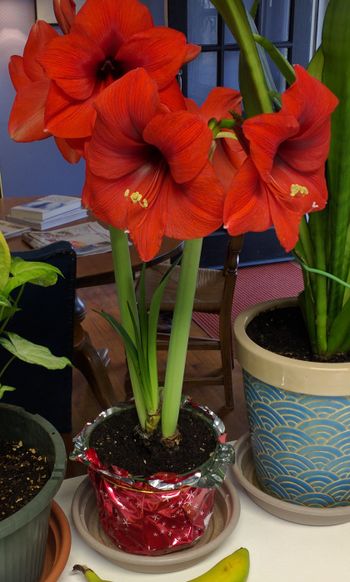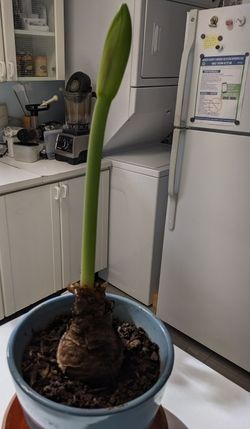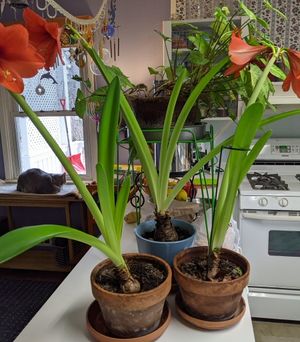Amaryllis
| Hippeastrum | ||||||||||||
|---|---|---|---|---|---|---|---|---|---|---|---|---|
| Scientific classification | ||||||||||||
|
Amaryllis is the common name for a group of showy ornamental perennial plants, formerly in the genus Hippeastrum and more recently again in the genus Amaryllis. Amaryllis is native to tropical South America, and most varieties require protection and care to thrive in temperate climates. There is commercial demand for these tropical bulbs which have been artificially manipulated to bloom in deep winter, producing flowers ranging in color from deep red to red-orange to white.
Life span and growing conditions
Amaryllis grow from bulbs. With proper care, an amaryllis bulb can survive for decades and will bloom at least once per year. Bulbs should be planted in well-draining soil with the top half of the bulb above soil. Amaryllis can tolerate both sun and shade but typically fare best in partial shade, with sunlight in the cool mornings and shade in the hot afternoons.
Soil and water
If planted in the ground outside, the soil should be mulched to help retain moisture, and bulbs will especially love being in shade during the hottest part of the day. Too much sunlight can lead to leaf burn, while flowering may be limited in full shade.
If planted in a pot, the pot should provide at least 2 inches of space around the outside of the bulb. Water whenever the soil becomes dry, especially in hot weather and if blooming. Soil should be well drained and not remain water-logged.
Temperature
Amaryllis thrive at room temperature (around 75° F) but will tolerate very hot weather if soil is kept moist and shade is available during times of high heat. They do best when the coolest temperature of the evening is above 50° F, and cannot survive temperatures approaching freezing. In temperate climates, bulbs will respond to shortening of days with a wilting and yellowing of foliage, and if planted outside, the bulbs must be moved to pots and brought inside before nights become too cold.
Over-wintering bulbs should ideally be kept in a cool garage or basement (around 50° F but less than room temperature) near a window where they receive natural light. If grown under artificial light, the timing of the light should be synchronous with natural daylight, as the change in the length of days will stimulate bulbs to begin new growth in early spring.
Nutrients
If planted outside in summers and brought indoors for winter, bulbs will probably not need feeding. But if kept potted indoors permanently, they will benefit from repotting with fresh soil annually and feeding during times of heavy growth, when days are longer.
Dormancy of bulbs during deep winter
In non-tropical climates, people can plant the bulbs outside from spring through fall. Well before freezing temperatures arrive in fall, the bulbs need transplanting to pots and moving to a cool storage area such as a basement where they can still receive at least low light. While dormant, they still require watering about once per week, as they are not dead. The bulbs will go dormant in late fall as the days shorten, but will begin growing again as soon as the days begin to lengthen. The bulbs can be planted outside again as soon as temperatures stop dropping below about 50 degrees Fahrenheit.
As bulbs begin to grow in early spring, they will try to bloom even before producing foliage. After producing one to three bloom stalks (depending on the strength and maturity of the bulb, as well as growing conditions), the bulb will spend its last energy producing huge, grass-like leaves. The foliage, once in place, begins to nourish the bulb, which bulks up in preparation for the next winter season.
After blooming, the bloom stalks eventually die. Although blossoms can be cut off, the stalk should ideally be left alone until it wilts of its own accord.
Propagation
There are two means of propagating amaryllis bulbs. The first is by bulb division. A healthy bulb may eventually put out child bulbs to the side, which once large enough possibly after a couple of growing seasons, can be separated carefully from the parent bulb. Alternatively, outdoor blossoms can be left undisturbed after blooming and allowed to "go to seed"; such blossoms may produce small seeds which scatter and germinate in loose soil, or can be harvested. Amaryllis grown from seeds will need to grow multiple years before their bulbs become large enough to create blossoms. The first year, their bulbs might reach around a centimeter, or about the size of a U.S. dime. By the second year, the bulb might double in size. After 3-5 years, once the bulb is close to 3 inches in size, the bulb may become strong enough to bloom.
For growers, reproduction by bulb division is preferred, because with seeds, it is impossible to know exactly what color will emerge unless the grower was very carefully able to control the pollination process.


